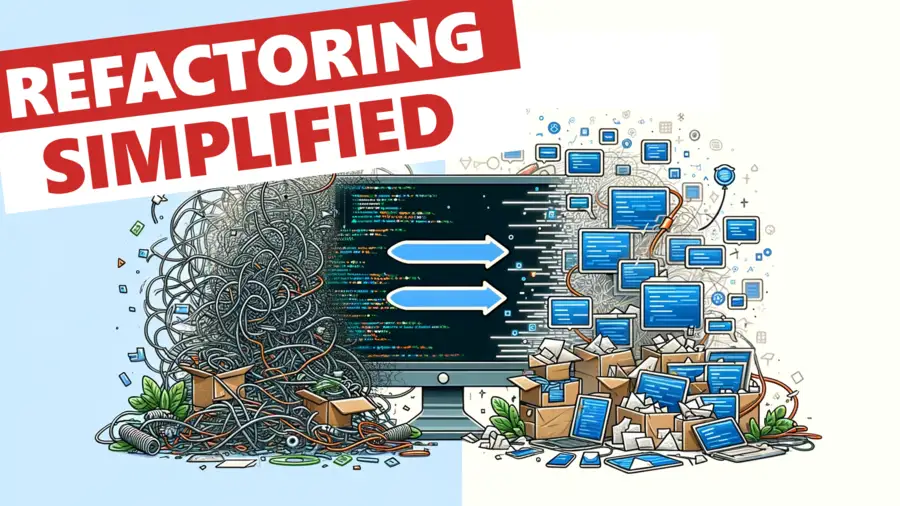To start off this article, let's define code refactoring. Code refactoring is the process of modifying code without changing its external behavior. Its goal is to improve code quality, code maintainability, and code efficiency. Refactoring code is essential for software development as it reduces code complexity and helps prevent bugs. Code refactoring can also enhance code readability and make it more accessible -- This is one of those things you want to prioritize for collaboration and long-term maintenance.
In this article, I'll provide guidance on how to simplify your code with effective code refactoring. I'll cover the benefits of code refactoring, best practices for code refactoring, and tips for effective code refactoring. My goal is to help you improve your code quality and become a better software engineer.
Benefits of Code Refactoring
When it comes to software engineering, refactoring code can have numerous benefits for developers and organizations. The following subsections will discuss code refactoring benefits across different areas of software development.
Simplify Code For Readability
Code refactoring can help simplify code, making it easier to read, understand, and maintain. This is especially important in large software systems that can become difficult to navigate and modify over time. By simplifying code, you reduce the time and effort needed to understand and modify it.
It's often overlooked, but as software developers, we spend more time reading code than we do writing it. This is true whether you're working on teams or working on your own codebase. We constantly need to be reading the code that exists, so it's critical that the code is optimized for being able to easily interpret.
Improve Code Maintainability
Code that is well-refactored generally means it's better structured and organized. This makes it easier to maintain, understand, and modify when bugs arise or when new features need to be added. Code that is not structured well can quickly become a nightmare to maintain or debug.
For anyone who has worked in codebases that are aging, this is extremely apparent. Even if developers are cognizant of tech debt and trying to reduce it, over time, a code base becomes more and more tricky to work in. Prioritizing maintenance is key for longevity.
Improve Code Efficiency
Code refactoring can help optimize code, making it run more efficiently. This not only leads to better performance but can also have an impact on the overall cost of running software, especially if it's deployed on a large scale.
Efficiencies can come from reducing redundant calls or even refactoring code to enable other algorithms to be used. As developers, we may often refactor code to enable access to new libraries/dependencies that offer different capabilities. As a result, you might also be unlocking better efficiency in your code.
Reduce Code Complexity and Prevent Bugs
Code refactoring can reduce the complexity of code and make it harder for bugs to hide. Refactored code that is well-structured and organized is easier to test, maintain, and upgrade. This means that fewer bugs will arise in the future, and the ones that do will be easier to find and fix.
Even better? Well-structured can be tested more effectively. If you have buggy code in the first place, it's likely your test coverage is not yielding you the results you're hoping for.
Benefits and Drawbacks of Code Refactoring Tools
Code refactoring tools can enhance software engineering practices. They help automate the refactoring process and make maintenance easier. For example, Visual Studio offers built-in refactoring tools that can simplify and optimize code. Other popular code refactoring tools include ReSharper, CodeRush, and NetBeans.
Benefits of Code Refactoring Tools
One major benefit of using code refactoring tools is that they can save time and effort. They automate repetitive and tedious tasks, allowing engineers to focus on more important areas of development. Moreover, tools like ReSharper can help prevent coding mistakes and improve code quality.
As a Visual Studio user, I often find myself in the context menu for renaming, extracting interfaces, or even code cleanup. The time savings are tremendous so investing some time to understand how you use your tools effectively will pay dividends.
Drawbacks of Code Refactoring Tools
In some cases, implementing code refactoring tools can also have drawbacks. Tools can sometimes introduce errors or unintended consequences. Some tools that are available can be costly and require time to integrate into existing workflows. Additionally, there is often a learning curve associated with mastering new tools. In my opinion, it's worth an investment into such tooling but it's important to understand that it's not always the case for immediate ROI.
So despite these drawbacks, the benefits of using code refactoring tools generally outweigh the drawbacks. If you're not currently using refactoring tools, it's highly recommended to investigate the options and see if they can improve your development workflow. At the time of writing, I still purely stick to Visual Studio but it's a reminder for even me to venture out further.
Are you interested in boosting your refactoring skills? Check out my course on Dometrain:
Refactoring for C# Devs: From Zero to Hero

Code Refactoring Tips and Best Practices
When refactoring code, it's important to adopt good software engineering practices to ensure that the process remains productive and efficient. Here are some best practices to keep in mind:
- Testing Code After Refactoring: Testing code after refactoring is crucial to ensure that there are no unexpected issues with the code. Testing helps detect issues that may have been introduced during the refactoring process. Ideally you have test coverage that can be run before and after to prove success.
- Testing for Edge Cases: Testing code for edge cases is critical for ensuring that the code works seamlessly in all situations. Edge cases refer to unusual or unexpected scenarios that may not be easily detectable without thorough testing.
- Agile Software Development Principles: The principles of agile software development, such as continuous refactoring, can be valuable when refactoring code. Agile development promotes continuous improvement, which helps ensure that code is always optimized for quality, functionality, and efficiency. I personally don't view "continuous refactoring" as meaning everything that can be refactored has equal or highest priority over other commitments.
- Improving the Quality of Refactored Code: When refactoring code, it’s important to strive for high-quality code that is maintainable and efficient. This can be achieved by adopting good software engineering practices such as testing, code documentation, and adherence to software development principles.
Tips for Effective Code Refactoring
Here are some tips to help make code refactoring more effective:
- Creating a Clear Plan Before Refactoring: Before starting the refactoring process, it's important to create a clear plan that outlines the goals and steps of the process. A plan helps ensure that the process remains organized and efficient. Even better -- Plan to have periodically delivered milestones so it's not landing significant changes all at once.
- Understanding the Purpose of Code Before Refactoring: Understanding the purpose of code is crucial when refactoring. It's important to have a good understanding of the code's purpose and functionality to ensure that the refactoring process addresses the code's key issues. Tests are a GREAT thing to lean on for this!
- Ensure No Breaks: Ensure that the code still works as intended after refactoring by testing the code after each refactoring step. Keeping the refactoring process small and incremental can also help ensure that the code remains intact and in working order.
- Refactoring Code in Small, Successive Steps: Breaking down code refactoring into small, successive steps is useful for ensuring that the process remains manageable and organized. This approach also enables developers to test the code after each refactoring step and easily track changes made during the process.
There are many code refactoring benefits, and following these tips is a great way to set you on the right path. I have found that one of the most effective code refactoring strategies is ensuring that you can refactor code in small steps. You don't get to realize any of the code refactoring benefits if your refactor turns into a 4-month-long branch that gets canceled because you couldn't merge your changes in!
Take Advantage Of These Code Refactoring Tips!
Code refactoring should be a priority skill to practice for software engineers and developers. Using code refactoring tips and techniques that I've gone over, you can improve code quality, maintainability, readability, efficiency, and prevent bugs in your codebase. While these code refactoring tips won't prevent all of the problems, they can help get you out of a pinch!
When refactoring code, it's ideal to adhere to industry best practices such as continuous testing and delivering in increments. Adopting these practices is vital to improving the quality of refactored code and ensuring you're in for a less bumpy ride!
Remember to check out my course on Dometrain: Refactoring for C# Devs if you want to skill up on your refactoring! If you're interested in more learning opportunities, subscribe to my free weekly newsletter and check out my YouTube channel!
Affiliations
These are products & services that I trust, use, and love. I get a kickback if you decide to use my links. There’s no pressure, but I only promote things that I like to use!
- BrandGhost: My social media content and scheduling tool that I use for ALL of my content!
- RackNerd: Cheap VPS hosting options that I love for low-resource usage!
- Contabo: Affordable VPS hosting options!
- ConvertKit: The platform I use for my newsletter!
- SparkLoop: Helps add value to my newsletter!
- Opus Clip: Tool for creating short-form videos!
- Newegg: For all sorts of computer components!
- Bulk Supplements: Huge selection of health supplements!
- Quora: I answer questions when folks request them!
Frequently Asked Questions: Code Refactoring Benefits
What are the benefits of code refactoring?
Code refactoring can simplify code, improve maintainability, enhance readability, improve efficiency, reduce complexity, and prevent bugs. By improving code quality, businesses can achieve faster time to market, increased customer satisfaction, and reduced maintenance costs.
What are common code refactoring techniques?
Common code refactoring techniques include refactoring for better structure and organization, using the extract method technique, extract class technique, replace nested conditional technique, switch statement refactoring technique, and more. Adopting these techniques can help improve code quality and maintainability.
What are the benefits of code refactoring tools?
Code refactoring tools can help automate the refactoring process, reducing the time and manual effort required. They can help catch errors and improve code quality, making the process more efficient and effective. However, the use of such tools can also introduce errors or unexpected behaviors, so it's important to use them with caution.
What are best practices for code refactoring?
Adopting good software engineering practices, testing code after refactoring, testing for edge cases, documenting code, and following agile software development principles like continuous refactoring are all crucial best practices for code refactoring. These practices can help improve the quality and maintainability of refactored code.
What are tips for effective code refactoring?
Creating a clear plan before refactoring, understanding the purpose of the code, ensuring that code refactoring does not break code, and refactoring code in small, successive steps are all commonly used best practices for effective code refactoring. These tips can help make the process more efficient and effective, while minimizing the risk of introducing errors or unexpected behaviors.

